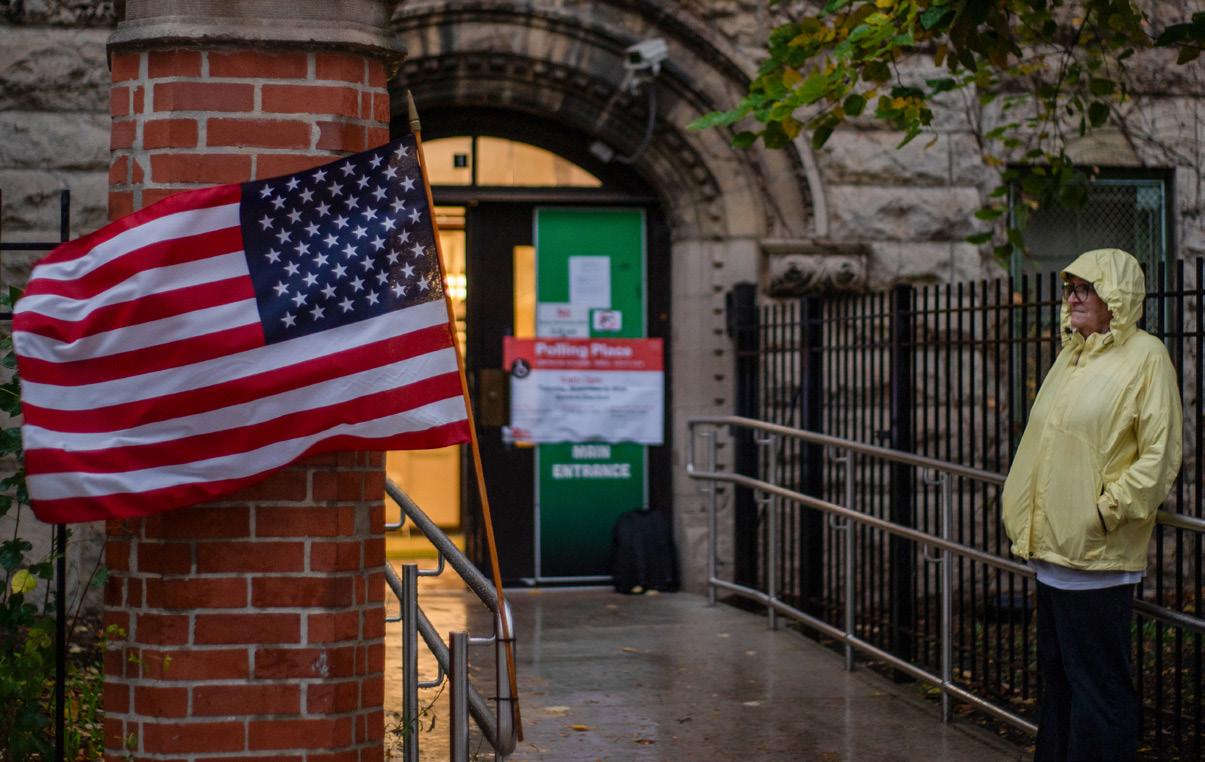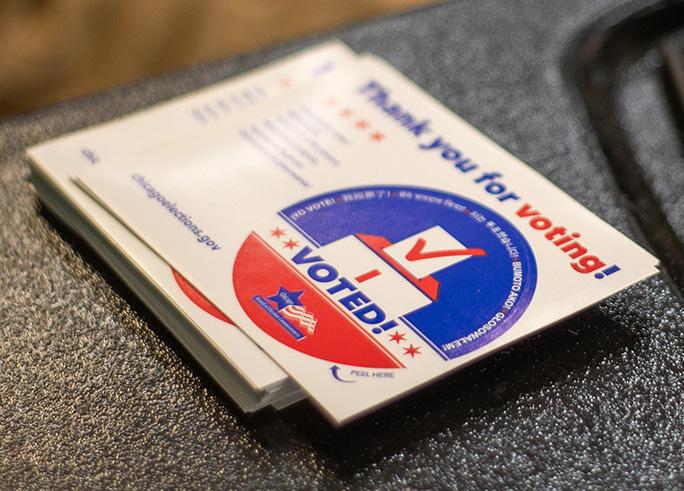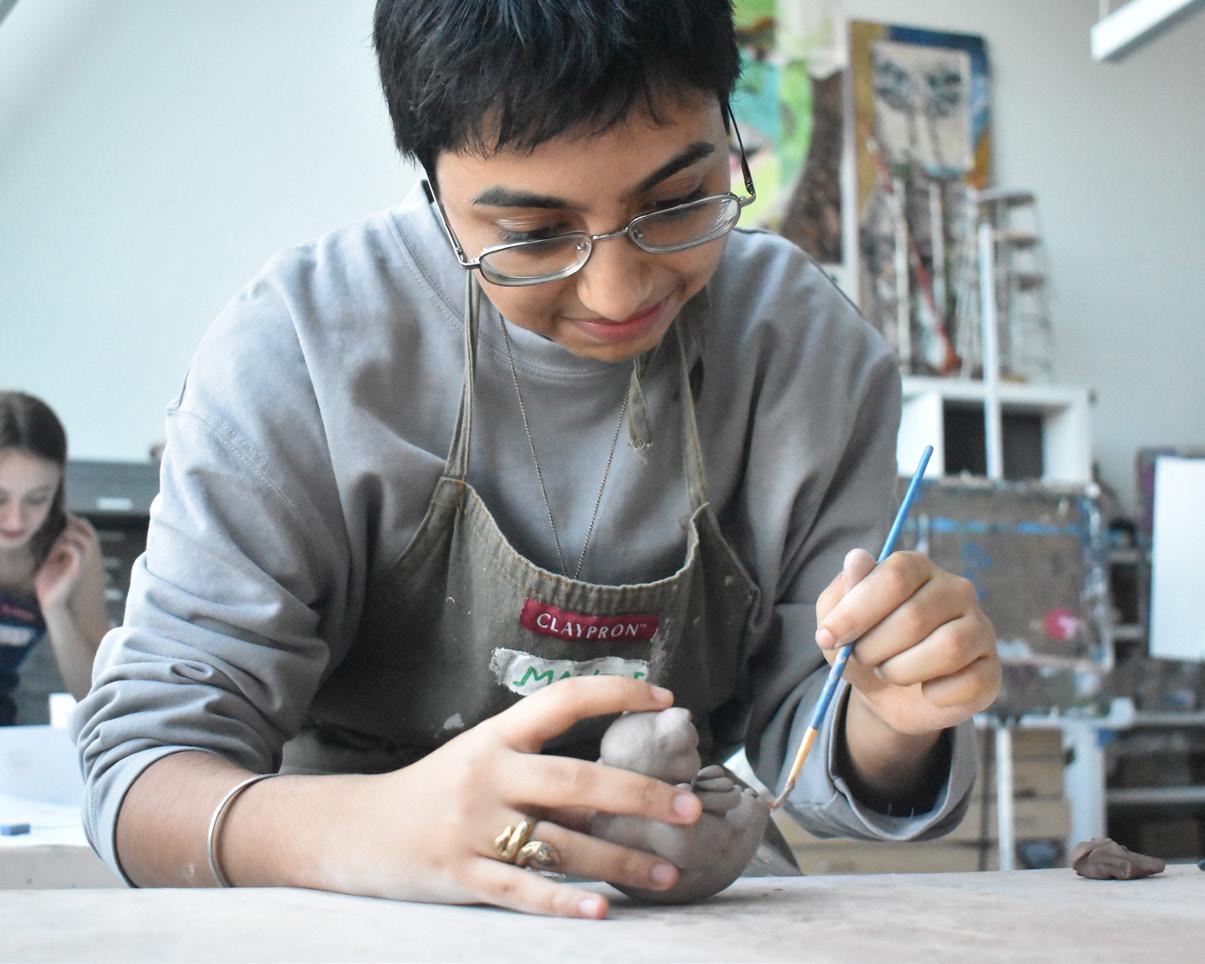100TH YEAR
NOVEMBER 19, 2024
Volume 100, Number 5
1362 East 59th Street
Chicago, Illinois 60637
uhighmidway.com
University of Chicago Laboratory High School

NOVEMBER 19, 2024
Volume 100, Number 5
1362 East 59th Street
Chicago, Illinois 60637
uhighmidway.com
University of Chicago Laboratory High School
Students perceive missing classes as unfeasible, taxing
by SKYE FREEMAN Features Editor
The Laboratory Schools urges students to take days off for mental and physical health reasons or religious holidays, yet students say the pressure to be in class overrides the opportunity to miss school.
Some feel that academic pressure is the cause and that the stakes of succeeding in school shouldn’t be so high.
Senior Orly Eggener attended school on Rosh Hashanah, the Jewish new year, despite having the option to miss school. Her reason? Too much work.
“I would’ve wanted to if I felt like I wouldn’t be totally stressed out after, but I had a paper that week, and I don’t do well if I don’t learn a math lesson in person, and I just thought it would be too hard,” Orly said. “It didn’t feel like it would be the right choice.”
U-High allows students up to 20 absences a year with a limit of 10 per semester. While that may seem like a lot, they can quickly be used on religious holidays or for recovery from sickness and stress.
“You’re up late and it sometimes feels like there’s no break, and even if you’re not in the best place, it’s really hard to miss school,” Orly said.
A lot of seniors share her sentiment. With so much to prepare for college, having time off is necessary, especially considering the amount of burnout students feel.
“For mental health days,” senior Hana Javed said, “it’s really important — especially for upperclassmen with everything that’s

PILING UP THE PRESSURE . Students face the dilemma of needing time off versus the fear of losing ground in coursework. The pressure to stay on track leaves little room for rest, even when it’s most needed.
going on with college and preparing for our futures — it’s important to take some time to rest because otherwise we’re all just going to burn out.”
Hana says it’s not fair to teachers either, and the same applies to sick days. Instead of staying home, sniffling and sneezing students roam school hallways.
“No one wants people who are sick to come to school,” Hana said.
“So, it just makes the whole environment just more isolated — because people don’t want to hang out with a sick person — but they shouldn’t even be there when
they’re sick.”
Sick students should stay home and rest instead of exposing others, but they say the fear of missing school surpasses that need. Even if an absence is excused, missing school is too risky.
“You have to email all of your teachers,” Orly said, “and it’s fair, but they probably won’t get back to you that soon and respond when you need to do the homework, so it keeps piling up.”
Students feel the school should have a more sound absence plan, with specific excused absence slips for mental health days and re-
ligious holidays.
Sophomore Arjun Sawhney says students should be granted more time to complete the work they’d been assigned while gone.
“If you miss one day of school,” he said, “you really miss a lot, and you end up spending your mental health day re-doing what was done in class.”
While the answer is unclear, the situation raises the question: Why are the stakes of school so high that students can’t miss even one day of school to rest, recover or observe faith?
Dean of Students Ana Campos
“
You’re up late and it sometimes feels like there’s no break, and even if you’re not in the best place, it’s really hard to miss school.
— Orly Eggener, senior ”
says that it is only a perception, and students push themselves to do their best to be strong applicants for the nation’s top universities, not realizing they’ll do fine wherever they go.
“This idea that there’s just a small, small group of schools that are, like, ‘If you go there, you’re successful, and if you go anywhere else, good luck,’ is toxic.”
Ms. Campos says she is constantly trying to provide support for students, whether that’s through offering mental health days or giving students the freedom to design their own schedules.
“That’s a part of the process here. We want students to really learn how to navigate and manage their time,” she said. “Initially, people are like, ‘Oh my god. This is amazing, this is awesome.’ But if they don’t use their time well, quickly they’re gonna start to feel overwhelmed because everything’s gonna start to catch up with them.”
Even if it’s using a few of the free lab periods to meet with teachers or visit the writer’s center, Ms. Campos says students are given lots of opportunities to receive help, so they can take the time to observe religious holidays or take a stress-free mental health day.
“Almost everything we do at Lab,“ she said, “we give kids autonomy.”
by MIA LIPSON & ABHAY CHANDRAN
Members of the Lab community had strong reactions to the Nov. 5 election of former president Donald Trump, with many feeling intense disappointment in the results and fear of the changes a second Trump administration will bring.
Many teachers began classes by addressing the results of election night on Nov. 6. Learning and counseling faculty hosted several post-election community gatherings and during lunch on Nov. 7, a coalition of groups, including Active Minds, Black Students’ Association, Young Men of Color and Young Women of Color, hosted a joint gathering to offer a safe and supportive space for students to debrief the results of the election.
Senior Juliana Walker, the president of Active Minds and co-president of BSA and Young Women of Color, said students used this space to express their frustration but also to think about what the results might say about the United States as a nation.
“This election was important to
“
This election was important to many people because the political leaders elected could possibly infringe upon our rights and well-being.
— Juliana Walker, senior ”
many people because the political leaders elected could possibly infringe upon our rights and well-being, and the results offered America a glimpse into the omnipresent systems of discrimination at play,” Juliana said.
Some members of the community expressed disappointment after Democratic nominee Kamala Harris’ campaign brought the possibility for historic representation of women of color.
Sophomore Isaac Sutherland canvassed for Harris in Wisconsin, a key swing state which ultimately went to Mr. Trump. Isaac said he felt demotivated by these results.
Isaac said, “I think that next election I’ll go out and volunteer even
more. The election has also kind of reminded me that the side that I think is right doesn’t always win, and that if it is going to win, I and everyone else has to fight hard.”
Senior Oliver Wilson was one of the few students who was not disappointed in the election results and credited the shift from 2020 to the “tumultuous past four years.”
“I think that Trump’s overwhelming margins of victory reflect not only a yearning for change in economic policy but social sentiment as well,” Oliver said.
Following the results of election night, some students expressed concern over how a second Trump administration would impact them. One issue that has students worried is Mr. Trump’s stance on abortion access.
Sophomore Laurel Farmer said she found it heartbreaking that abortion may be even harder for some women to access.
Some students expressed concern over the policies proposed in Project 2025, a political blueprint for a Republican administration published by the Heritage Foundation, a conservative think tank.

and
Project 2025 was written by many of Mr. Trump’s former allies and aides, though Mr. Trump denies knowing anything about it.
“We can’t know whether or not he is actually ready to go through with all of that. He has publicly denounced it,” sophomore Valkyrie
Laurence said. “However, it’s hard to be sure because he clearly does not have the longevity of the Republican Party in mind, nor does he particularly seem to care about what his actions end up doing.” Additional reporting contributed by Edward Park.
Reflect on recent election by turning frustration into substantive change
After the Nov. 5 presidential election many in our com munity are feeling hurt and overwhelmed. We understand the deep disappointment, fear and confusion that so many are experiencing.
In a time of political unrest and polarization, it is critical to acknowledge that significant results can take some time to process, especially when these issues impact us directly. Academic pressures, personal challenges or the ongoing crises faced by people globally all add to the feelings of stress and upheaval after the election. It’s OK to take time to step back and process these emotions to fully comprehend and process your feelings.
When election results don’t turn out with the general consensus of U-High students, they can contribute to and provoke strong and sometimes conflicting feelings and emotions. It is natural to feel disheartened and angry when something you are so passionate about doesn’t go the way you believe it should. We can take these emotions and invest them in our democracy, government and future, creating solutions we deeply care about. By doing this, we can help ensure our voices are heard in a meaningful way. We know many are experiencing feelings of helplessness or resignation, but we can gather that feeling and use it to fight for change.
The presidential election is not the only election. We vote every two years. In 2026, Senate and
This represents the opinion of the U-High Midway editorial board.
House seats open up, providing a valuable opportunity for voters to usher in change — just like in the presidential election. While the results of the most recent presidential election may have been deeply personal for so many, we must also remember that it is a civic duty for citizens to participate in local or midterm elections.
By 2026, for instance, over half the current population of U-High will be eligible to vote. So, take the time and become a registered voter. Your participation in future elections can help bring about the change that you as a citizen want to see.
It is also important to remember that even while the president is the most visible member of the government, the government is for the people and by the people. Learning about candidates for local positions can lead to changes that affect you on a closer scale. Attend the monthly committee meetings, and email your alderperson or local representative about thoughts and opinions you want to express. Many pathways for change are available, but it’s up to you to go take them.

Additionally, you have a voice. Whether through peaceful protest, raising awareness on social media or organizing community efforts for change, your actions can send a strong, impactful message. Speaking out about your opinions and feelings is one of the strongest avenues to demonstrate your commitment for change. The collec-
tive unity of empowered individuals can create meaningful and lasting change that can cause ripple effects leading to societal change you want.
Remember, while the road for change may be filled with roadblocks and bumps, it begins by acknowledging and possibly appreciating how deeply we care about issues important to our community. Furthermore, taking the passion and determination brought by those emotions and channeling them into productive change can help bring about a future you want. Through unity and commitment we can navigate these turbulent times and come together to build a society that we are happy with.
by LIGHT DOHRN
Arts & Entertainment Editor
In a quiet corner of the U-High ceramics studio, the scent of clay and glaze mingle in the air as students lean over their work, lost in the flow of creation. The hum of soft music from a class-made playlist and the whir of potter’s wheels fill the space, creating an atmosphere where time seems to slow. But for many, moments like these are exceedingly rare.
At U-High, many students — and teachers — feel art has become an afterthought or a fleeting interest overshadowed by the weight of STEM classes and academic commitments. Finding time for creativity can seem impossible, leaving students feeling disconnected from artistic expression. The closer students get to college applications and shift their focus to scores and credentials, the question becomes increasingly pressing: Is art lost in the pursuit of academic achievement?
Junior Carolyn Payne has been taking Art History with teacher Jason Pallas this year, which occurs during her Wednesday and Thursday lab periods. The course is mainly made up of field trips: traveling to art museums to meet creators, curators or employees

who then walk them through different aspects of art history — and Carolyn describes her class experience as a “detox from competition.” U-High is, and has long been, a hub of extremely gifted students all trying to discover and prove
what sets them apart — but in an art class, Carolyn is able to take a breath and explore her passion without the pressure to win.
“You’re able to be around people who are also interested in such an uncompetitive nature and environ-
ment, and it lets you be creative, think about creativity and meet creative people,” Carolyn said.
Fine arts department co-chair
Ana Romero said the disconnect between students and art has become apparent in recent years, a surprise to both her and her colleagues. She believes the undeniable benefits of artistic creativity in a school environment must be considered when it comes to a student building their schedule.
“Many of us in the department do feel that although we are not counselors or art therapists, we know the benefits of a class where you can use your creative skills, you can use your hands, you can use your body like in theater — there are serious health benefits to engaging in creative spaces with teachers and with peers,” Ms. Romero said.
Ms. Romero emphasized the difficulty of exploring the unfamiliar and suggested that students should be encouraged to take risks in areas they might overlook. By stepping into new classes, students may discover unexpected talents and learn that art isn’t limited to perfect technique but can be about personal expression, growth and discovery.
“I, and I think most teachers in
this school, support kids going for their interests, because that’s why you’re here,” Ms. Romero said. “But sometimes students don’t understand the potential that exists within a class that they would never think twice about taking.”
Carolyn also believes that in a school where academic and career-driven ambitions dominate, there’s an unspoken assumption that subjects like art are secondary or even disposable.
“I think we see the Lab’s lack of emphasis on art through kids just taking art classes because of the requirement,” Carolyn said. “And I think we see a lot of lack of ambition when it comes to art as well. I often feel like there are some kids who take it as almost a free period and do homework for other classes during it, even though it’s still, you know, a class.”
Within those moments in U-High’s art studios or trips to museums, students like Carolyn find relief from the academic rigor that defines so much of their high school experience. For her and others, art can be more than just a class — it’s a place to breathe, reflect, and embrace creativity on their own terms as competition and anxiety fade, for an hour or two, into the background.